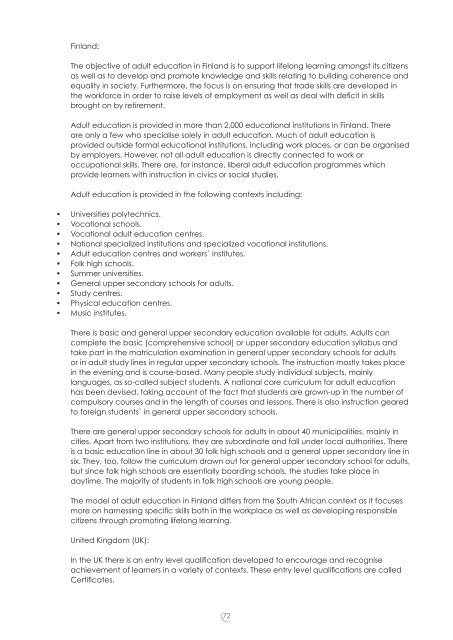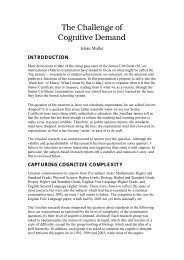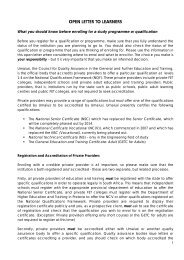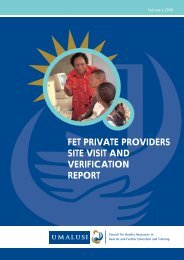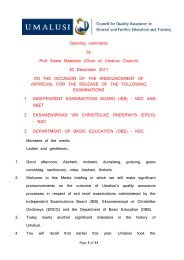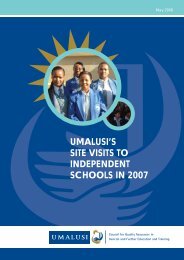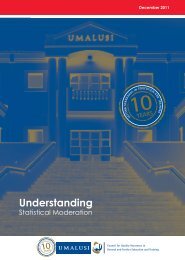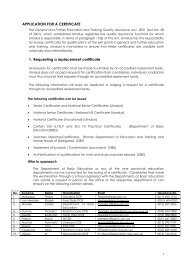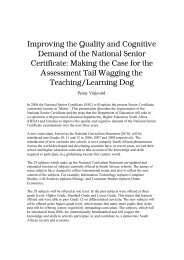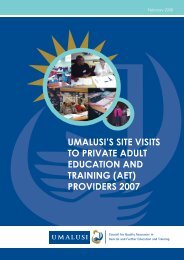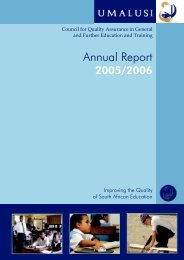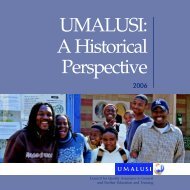Inspecting the Foundations - Umalusi
Inspecting the Foundations - Umalusi
Inspecting the Foundations - Umalusi
Create successful ePaper yourself
Turn your PDF publications into a flip-book with our unique Google optimized e-Paper software.
Finland:The objective of adult education in Finland is to support lifelong learning amongst its citizensas well as to develop and promote knowledge and skills relating to building coherence andequality in society. Fur<strong>the</strong>rmore, <strong>the</strong> focus is on ensuring that trade skills are developed in<strong>the</strong> workforce in order to raise levels of employment as well as deal with defi cit in skillsbrought on by retirement.Adult education is provided in more than 2,000 educational institutions in Finland. Thereare only a few who specialise solely in adult education. Much of adult education isprovided outside formal educational institutions, including work places, or can be organisedby employers. However, not all adult education is directly connected to work oroccupational skills. There are, for instance, liberal adult education programmes whichprovide learners with instruction in civics or social studies.Adult education is provided in <strong>the</strong> following contexts including:• Universities polytechnics.• Vocational schools.• Vocational adult education centres.• National specialized institutions and specialized vocational institutions.• Adult education centres and workers` institutes.• Folk high schools.• Summer universities.• General upper secondary schools for adults.• Study centres.• Physical education centres.• Music institutes.There is basic and general upper secondary education available for adults. Adults cancomplete <strong>the</strong> basic (comprehensive school) or upper secondary education syllabus andtake part in <strong>the</strong> matriculation examination in general upper secondary schools for adultsor in adult study lines in regular upper secondary schools. The instruction mostly takes placein <strong>the</strong> evening and is course-based. Many people study individual subjects, mainlylanguages, as so-called subject students. A national core curriculum for adult educationhas been devised, taking account of <strong>the</strong> fact that students are grown-up in <strong>the</strong> number ofcompulsory courses and in <strong>the</strong> length of courses and lessons. There is also instruction gearedto foreign students` in general upper secondary schools.There are general upper secondary schools for adults in about 40 municipalities, mainly incities. Apart from two institutions, <strong>the</strong>y are subordinate and fall under local authorities. Thereis a basic education line in about 30 folk high schools and a general upper secondary line insix. They, too, follow <strong>the</strong> curriculum drawn out for general upper secondary school for adults,but since folk high schools are essentially boarding schools, <strong>the</strong> studies take place indaytime. The majority of students in folk high schools are young people.The model of adult education in Finland differs from <strong>the</strong> South African context as it focusesmore on harnessing specifi c skills both in <strong>the</strong> workplace as well as developing responsiblecitizens through promoting lifelong learning.United Kingdom (UK):In <strong>the</strong> UK <strong>the</strong>re is an entry level qualifi cation developed to encourage and recogniseachievement of learners in a variety of contexts. These entry level qualifi cations are calledCertifi cates.72


